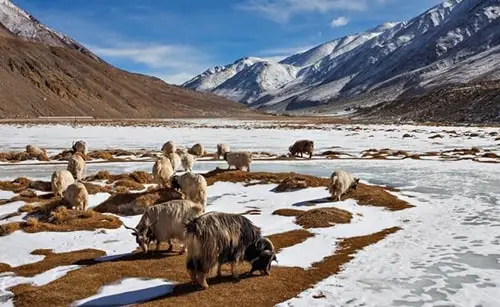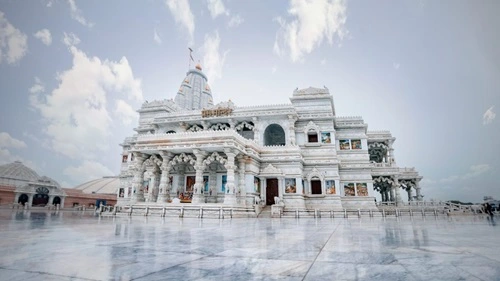You see, there are around 106 national parks in India, and that goes to show how dedicated our nation is to protecting the flora and fauna of the Indian subcontinent. But out of these 106 national parks, there are a few that stand out the most, specifically for the insane land area that they cover. And today, we are going to take a good look at the top 10 biggest national parks in India as of 2024. So, why not get started right away?
1. Hemis National Park, Jammu and Kashmir

Starting off with a bang, we have Hemis National Park at the very top, and why not? This park is not just the largest in India, covering an impressive 4,400 square kilometers, but it’s also a pivotal hub for the conservation of the elusive snow leopard. It is a mixed landscape that presents visitors with different moods, whether from the lush green valleys to the stark beauty of a high-altitude desert. This is more than just a park, it represents the lifeline of species like the Tibetan wolf, the Eurasian brown bear, and the red fox. So seriously, it is a must-visit for anyone dedicated to the conservation of Himalayan wildlife.
2. Desert National Park, Rajasthan
And, next in line, let’s proceed to the state of Rajasthan, which houses the Desert National Park that spans an area of 3,162 square kilometers of the famous Thar Desert. In such conditions, the park buzzes with life and hosts the critically endangered Great Indian Bustard. Picture endless sand dunes with some scrublands, pretty wild. This park plays a critical role in the wildlife and maintains the ecological balance of the desert. Believe us, the view of life thriving here is nothing but spectacular.
3. Gangotri National Park, Uttarakhand
Now that brings us to Gangotri National Park, which is spread over an area of 2,390 sq. km. Not only is it a land of biodiversity, but it is also massively spiritual, for the source of the River Ganges is within its limits. Gangotri houses species that can be found from the chilling alpine to the lavish subalpine meadows and includes other species like the Himalayan tahr and blue sheep, which are adapted to cold conditions. So, if you believe in the infusion of the element of the spiritual aspect and natural exploration, then Gangotri is one stop that cannot be missed.
4. Namdapha National Park, Arunachal Pradesh
Heading over to Arunachal Pradesh, Namdapha National Park covers 1,985 square kilometers and is a treasure trove within the Eastern Himalayas. What’s unique here? You see, this is the only national park in India where the big four: tiger, leopard, snow leopard, and clouded leopard, exist. Right from the tropical rainforest below to the mystic alpine meadows above, it happens to be a critical conservation site and a spectacular showcase of biodiversity.
5. Khangchendzonga National Park, Sikkim
Fifth is the Khangchendzonga National Park in Sikkim, with an enormous landmass of about 1,784 square kilometers. It is named after the majestic Mount Khangchendzonga. It is not only a park, it is in fact a World Heritage Site where one can have a view of huge glaciers, calm lakes, and wide meadows. This park also hosts flora and fauna such as the red panda and serves as a habitat for the majestic snow leopard.
6. Guru Ghasidas (Sanjay) National Park, Chhattisgarh
Now, this park isn’t just another park, it is again one of the largest national parks in India, sprawling over an area of 1,440.7 square kilometers. Rather, it is an emerald oasis in those parts. It hosts dense sal and bamboo forests that support a great number of wildlife species, from tigers to leopards. In that case, for every nature and animal lover, probably, a walk across the park will sound like paradise to you.
7. Gir Forest National Park, Gujarat
Now going over to Gujarat, we have Gir Forest National Park. You must have heard about it, right? Well, you should, because that happens to be the only place in the wild where Asiatic lions can be found! That actually covers 1,412 square km, though it isn’t just about lions. This national park is home to leopards and hyenas as well, along with a number of species of deer and antelopes. So, visiting Gir, you surely have a lot to see and, most importantly, such big lions moving around wild! Trust us, that’s a sight you don’t want to miss!
8. Sundarbans National Park, West Bengal
The next one is the Sundarbans National Park, West Bengal, which spans 1,330.1 square kilometers. The place is gargantuan, being part of the largest mangrove forest in the world. It is no ordinary park but part of the UNESCO World Heritage Site, in association with the Ganges delta, and home to the Royal Bengal Tiger, you know? The mangroves here have a great role in protecting the inland areas from storms and rising sea levels.
9. Jim Corbett National Park, Uttarakhand
Okay, let’s talk about Jim Corbett National Park, which is like the most historic national park in the country. It covers a land area of 1,318.5 square kilometers and has the distinction of being one of the oldest national parks in the country, and the first in the network under the Project Tiger initiative. The park represents a variety of geographical features: from the ridges and small plateaus to the riverine belts, the rolling plains, and the narrow valleys. And wildlife? Oh, it is abundant with fauna such as the Bengal tiger, elephants, and hundreds of bird species.
10. Indravati National Park, Chhattisgarh
At last, we’re back in Chhattisgarh, in the Indravati National Park. Extending over 1,258.4 square kilometers, and as you can guess, it was named after the famous Indravati River. It is one of the important sanctuaries for Wild Asian Buffaloes and, indeed, a critical tiger reserve. The park forms a beautiful mosaic of deep tropical forests and hilly terrains, absolutely perfect for any wildlife enthusiast or photographer for that matter.
Conclusion
There you have it. If you truly want to experience the wildlife and natural beauty of India, these are the must-visit national parks in the nation. And it is not just about the huge land area, nah, instead it is more about preserving the wildlife and nature.

